Business Information Systems: Internal, External Processes and ICTs
VerifiedAdded on 2020/05/08
|5
|1115
|408
Report
AI Summary
This report examines information systems within a business context, focusing on the identification and analysis of internal and external processes. It explores how businesses like Coles, Woolworths, and Aldi can leverage information and communication technologies (ICT) to optimize these processes, particularly in Business-to-Business (B2B) scenarios. The report discusses the significance of the Business Process Analysis model and how ICT tools can improve efficiency, data analysis, and collaboration. Furthermore, it highlights the importance of aligning business strategies with both internal and external factors to achieve strategic objectives, improve marketing tactics, and enhance overall business performance. The report also covers how ICT applications support B2B processes by simplifying IT complexities and improving competitive advantages. The report uses various sources to support its analysis.
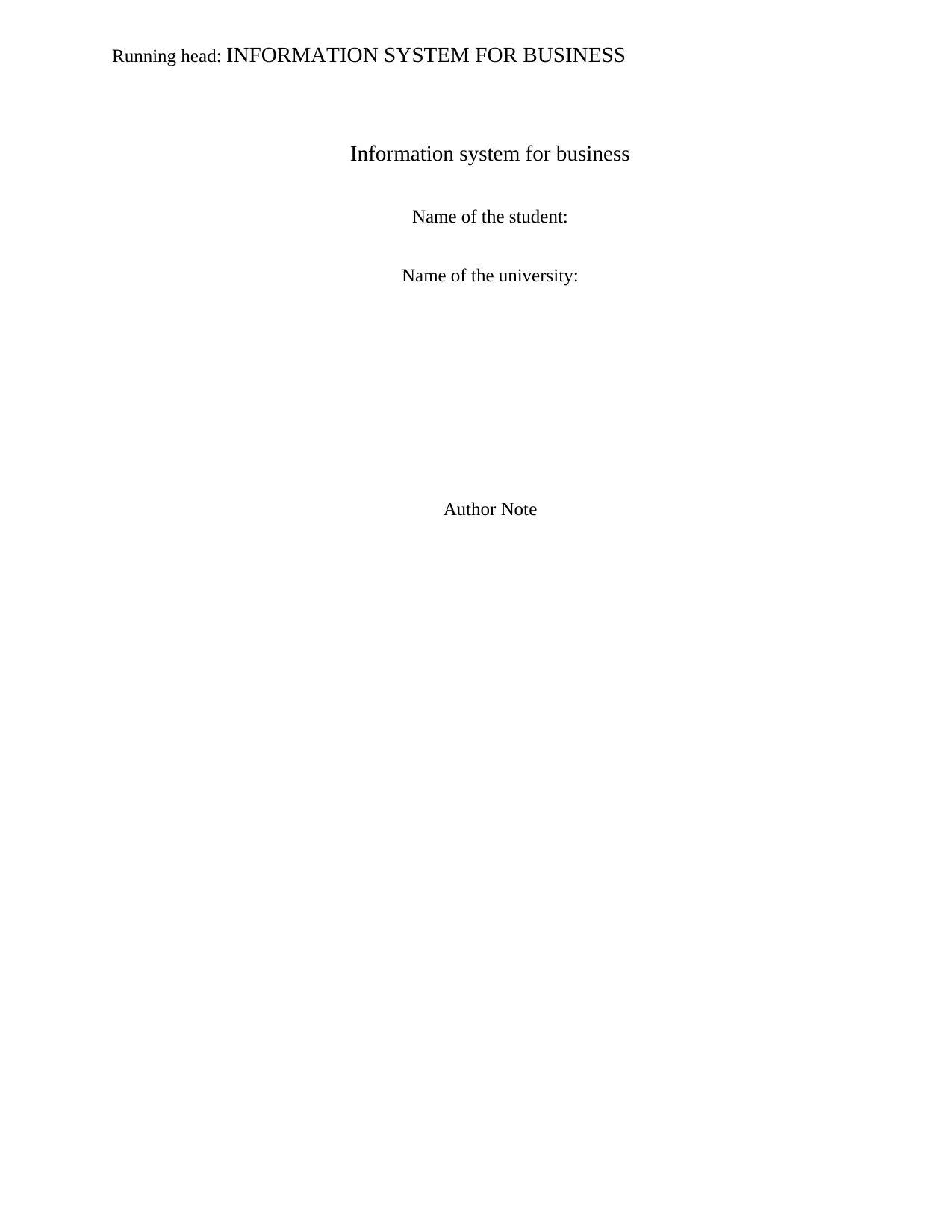
Running head: INFORMATION SYSTEM FOR BUSINESS
Information system for business
Name of the student:
Name of the university:
Author Note
Information system for business
Name of the student:
Name of the university:
Author Note
Paraphrase This Document
Need a fresh take? Get an instant paraphrase of this document with our AI Paraphraser
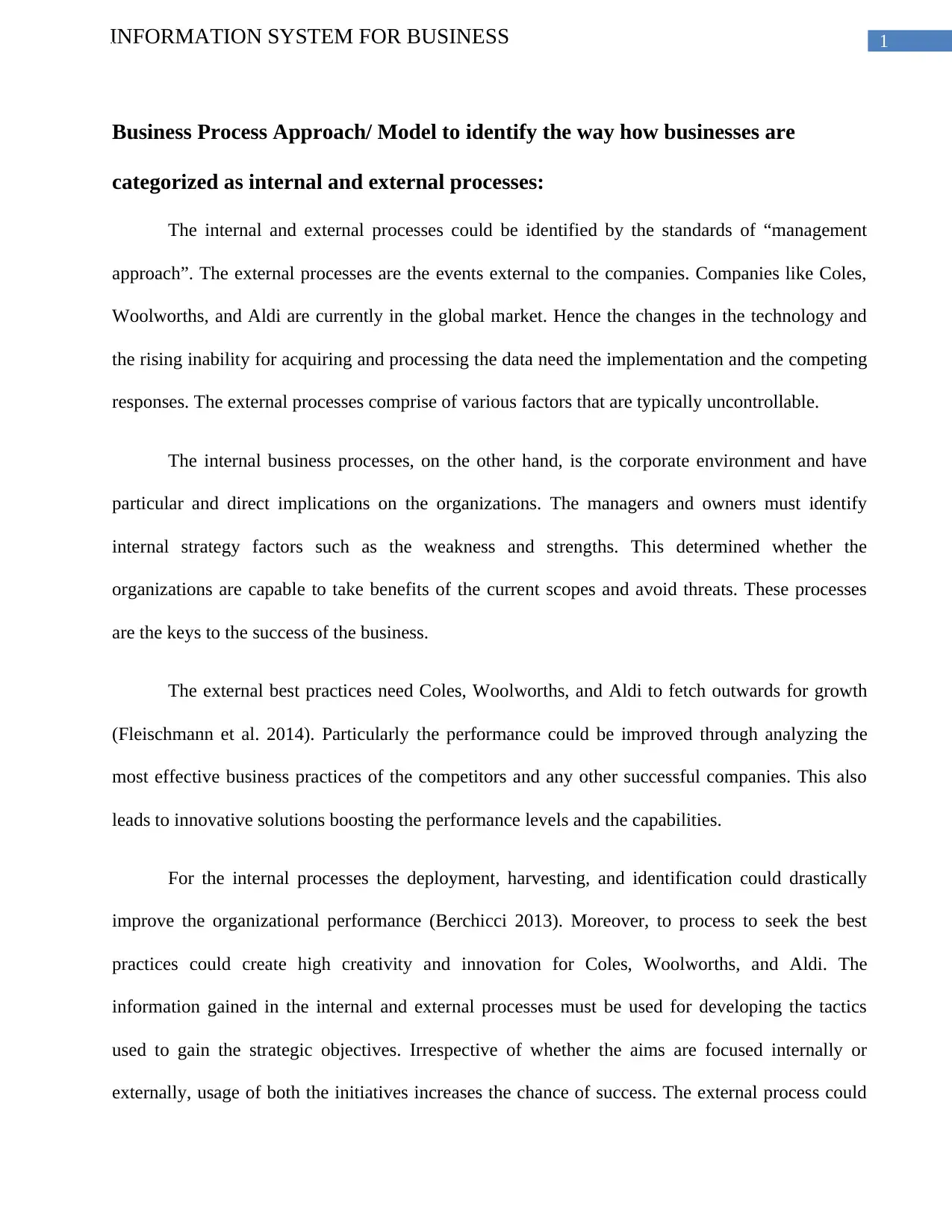
1INFORMATION SYSTEM FOR BUSINESS
Business Process Approach/ Model to identify the way how businesses are
categorized as internal and external processes:
The internal and external processes could be identified by the standards of “management
approach”. The external processes are the events external to the companies. Companies like Coles,
Woolworths, and Aldi are currently in the global market. Hence the changes in the technology and
the rising inability for acquiring and processing the data need the implementation and the competing
responses. The external processes comprise of various factors that are typically uncontrollable.
The internal business processes, on the other hand, is the corporate environment and have
particular and direct implications on the organizations. The managers and owners must identify
internal strategy factors such as the weakness and strengths. This determined whether the
organizations are capable to take benefits of the current scopes and avoid threats. These processes
are the keys to the success of the business.
The external best practices need Coles, Woolworths, and Aldi to fetch outwards for growth
(Fleischmann et al. 2014). Particularly the performance could be improved through analyzing the
most effective business practices of the competitors and any other successful companies. This also
leads to innovative solutions boosting the performance levels and the capabilities.
For the internal processes the deployment, harvesting, and identification could drastically
improve the organizational performance (Berchicci 2013). Moreover, to process to seek the best
practices could create high creativity and innovation for Coles, Woolworths, and Aldi. The
information gained in the internal and external processes must be used for developing the tactics
used to gain the strategic objectives. Irrespective of whether the aims are focused internally or
externally, usage of both the initiatives increases the chance of success. The external process could
Business Process Approach/ Model to identify the way how businesses are
categorized as internal and external processes:
The internal and external processes could be identified by the standards of “management
approach”. The external processes are the events external to the companies. Companies like Coles,
Woolworths, and Aldi are currently in the global market. Hence the changes in the technology and
the rising inability for acquiring and processing the data need the implementation and the competing
responses. The external processes comprise of various factors that are typically uncontrollable.
The internal business processes, on the other hand, is the corporate environment and have
particular and direct implications on the organizations. The managers and owners must identify
internal strategy factors such as the weakness and strengths. This determined whether the
organizations are capable to take benefits of the current scopes and avoid threats. These processes
are the keys to the success of the business.
The external best practices need Coles, Woolworths, and Aldi to fetch outwards for growth
(Fleischmann et al. 2014). Particularly the performance could be improved through analyzing the
most effective business practices of the competitors and any other successful companies. This also
leads to innovative solutions boosting the performance levels and the capabilities.
For the internal processes the deployment, harvesting, and identification could drastically
improve the organizational performance (Berchicci 2013). Moreover, to process to seek the best
practices could create high creativity and innovation for Coles, Woolworths, and Aldi. The
information gained in the internal and external processes must be used for developing the tactics
used to gain the strategic objectives. Irrespective of whether the aims are focused internally or
externally, usage of both the initiatives increases the chance of success. The external process could
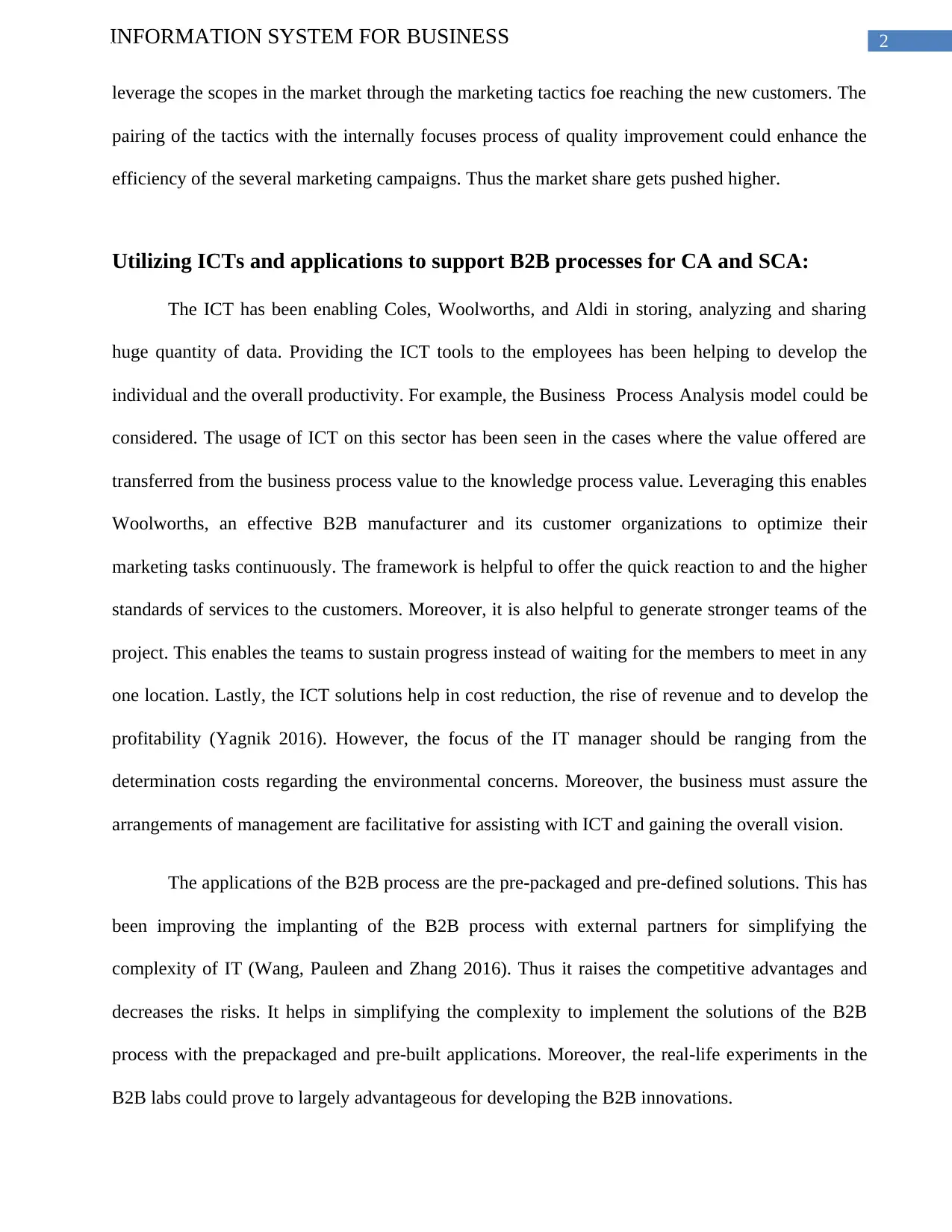
2INFORMATION SYSTEM FOR BUSINESS
leverage the scopes in the market through the marketing tactics foe reaching the new customers. The
pairing of the tactics with the internally focuses process of quality improvement could enhance the
efficiency of the several marketing campaigns. Thus the market share gets pushed higher.
Utilizing ICTs and applications to support B2B processes for CA and SCA:
The ICT has been enabling Coles, Woolworths, and Aldi in storing, analyzing and sharing
huge quantity of data. Providing the ICT tools to the employees has been helping to develop the
individual and the overall productivity. For example, the Business Process Analysis model could be
considered. The usage of ICT on this sector has been seen in the cases where the value offered are
transferred from the business process value to the knowledge process value. Leveraging this enables
Woolworths, an effective B2B manufacturer and its customer organizations to optimize their
marketing tasks continuously. The framework is helpful to offer the quick reaction to and the higher
standards of services to the customers. Moreover, it is also helpful to generate stronger teams of the
project. This enables the teams to sustain progress instead of waiting for the members to meet in any
one location. Lastly, the ICT solutions help in cost reduction, the rise of revenue and to develop the
profitability (Yagnik 2016). However, the focus of the IT manager should be ranging from the
determination costs regarding the environmental concerns. Moreover, the business must assure the
arrangements of management are facilitative for assisting with ICT and gaining the overall vision.
The applications of the B2B process are the pre-packaged and pre-defined solutions. This has
been improving the implanting of the B2B process with external partners for simplifying the
complexity of IT (Wang, Pauleen and Zhang 2016). Thus it raises the competitive advantages and
decreases the risks. It helps in simplifying the complexity to implement the solutions of the B2B
process with the prepackaged and pre-built applications. Moreover, the real-life experiments in the
B2B labs could prove to largely advantageous for developing the B2B innovations.
leverage the scopes in the market through the marketing tactics foe reaching the new customers. The
pairing of the tactics with the internally focuses process of quality improvement could enhance the
efficiency of the several marketing campaigns. Thus the market share gets pushed higher.
Utilizing ICTs and applications to support B2B processes for CA and SCA:
The ICT has been enabling Coles, Woolworths, and Aldi in storing, analyzing and sharing
huge quantity of data. Providing the ICT tools to the employees has been helping to develop the
individual and the overall productivity. For example, the Business Process Analysis model could be
considered. The usage of ICT on this sector has been seen in the cases where the value offered are
transferred from the business process value to the knowledge process value. Leveraging this enables
Woolworths, an effective B2B manufacturer and its customer organizations to optimize their
marketing tasks continuously. The framework is helpful to offer the quick reaction to and the higher
standards of services to the customers. Moreover, it is also helpful to generate stronger teams of the
project. This enables the teams to sustain progress instead of waiting for the members to meet in any
one location. Lastly, the ICT solutions help in cost reduction, the rise of revenue and to develop the
profitability (Yagnik 2016). However, the focus of the IT manager should be ranging from the
determination costs regarding the environmental concerns. Moreover, the business must assure the
arrangements of management are facilitative for assisting with ICT and gaining the overall vision.
The applications of the B2B process are the pre-packaged and pre-defined solutions. This has
been improving the implanting of the B2B process with external partners for simplifying the
complexity of IT (Wang, Pauleen and Zhang 2016). Thus it raises the competitive advantages and
decreases the risks. It helps in simplifying the complexity to implement the solutions of the B2B
process with the prepackaged and pre-built applications. Moreover, the real-life experiments in the
B2B labs could prove to largely advantageous for developing the B2B innovations.
⊘ This is a preview!⊘
Do you want full access?
Subscribe today to unlock all pages.

Trusted by 1+ million students worldwide
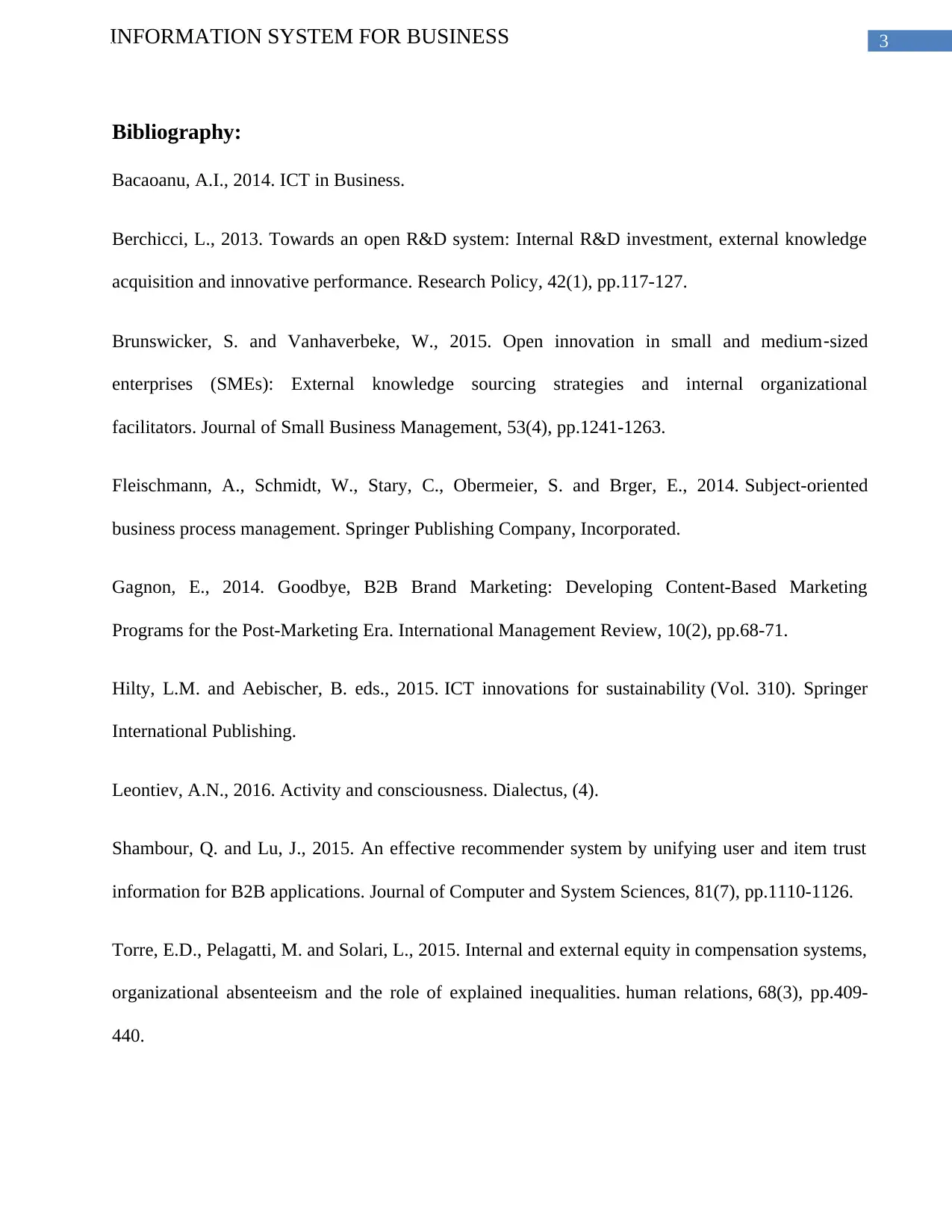
3INFORMATION SYSTEM FOR BUSINESS
Bibliography:
Bacaoanu, A.I., 2014. ICT in Business.
Berchicci, L., 2013. Towards an open R&D system: Internal R&D investment, external knowledge
acquisition and innovative performance. Research Policy, 42(1), pp.117-127.
Brunswicker, S. and Vanhaverbeke, W., 2015. Open innovation in small and medium‐sized
enterprises (SMEs): External knowledge sourcing strategies and internal organizational
facilitators. Journal of Small Business Management, 53(4), pp.1241-1263.
Fleischmann, A., Schmidt, W., Stary, C., Obermeier, S. and Brger, E., 2014. Subject-oriented
business process management. Springer Publishing Company, Incorporated.
Gagnon, E., 2014. Goodbye, B2B Brand Marketing: Developing Content-Based Marketing
Programs for the Post-Marketing Era. International Management Review, 10(2), pp.68-71.
Hilty, L.M. and Aebischer, B. eds., 2015. ICT innovations for sustainability (Vol. 310). Springer
International Publishing.
Leontiev, A.N., 2016. Activity and consciousness. Dialectus, (4).
Shambour, Q. and Lu, J., 2015. An effective recommender system by unifying user and item trust
information for B2B applications. Journal of Computer and System Sciences, 81(7), pp.1110-1126.
Torre, E.D., Pelagatti, M. and Solari, L., 2015. Internal and external equity in compensation systems,
organizational absenteeism and the role of explained inequalities. human relations, 68(3), pp.409-
440.
Bibliography:
Bacaoanu, A.I., 2014. ICT in Business.
Berchicci, L., 2013. Towards an open R&D system: Internal R&D investment, external knowledge
acquisition and innovative performance. Research Policy, 42(1), pp.117-127.
Brunswicker, S. and Vanhaverbeke, W., 2015. Open innovation in small and medium‐sized
enterprises (SMEs): External knowledge sourcing strategies and internal organizational
facilitators. Journal of Small Business Management, 53(4), pp.1241-1263.
Fleischmann, A., Schmidt, W., Stary, C., Obermeier, S. and Brger, E., 2014. Subject-oriented
business process management. Springer Publishing Company, Incorporated.
Gagnon, E., 2014. Goodbye, B2B Brand Marketing: Developing Content-Based Marketing
Programs for the Post-Marketing Era. International Management Review, 10(2), pp.68-71.
Hilty, L.M. and Aebischer, B. eds., 2015. ICT innovations for sustainability (Vol. 310). Springer
International Publishing.
Leontiev, A.N., 2016. Activity and consciousness. Dialectus, (4).
Shambour, Q. and Lu, J., 2015. An effective recommender system by unifying user and item trust
information for B2B applications. Journal of Computer and System Sciences, 81(7), pp.1110-1126.
Torre, E.D., Pelagatti, M. and Solari, L., 2015. Internal and external equity in compensation systems,
organizational absenteeism and the role of explained inequalities. human relations, 68(3), pp.409-
440.
Paraphrase This Document
Need a fresh take? Get an instant paraphrase of this document with our AI Paraphraser
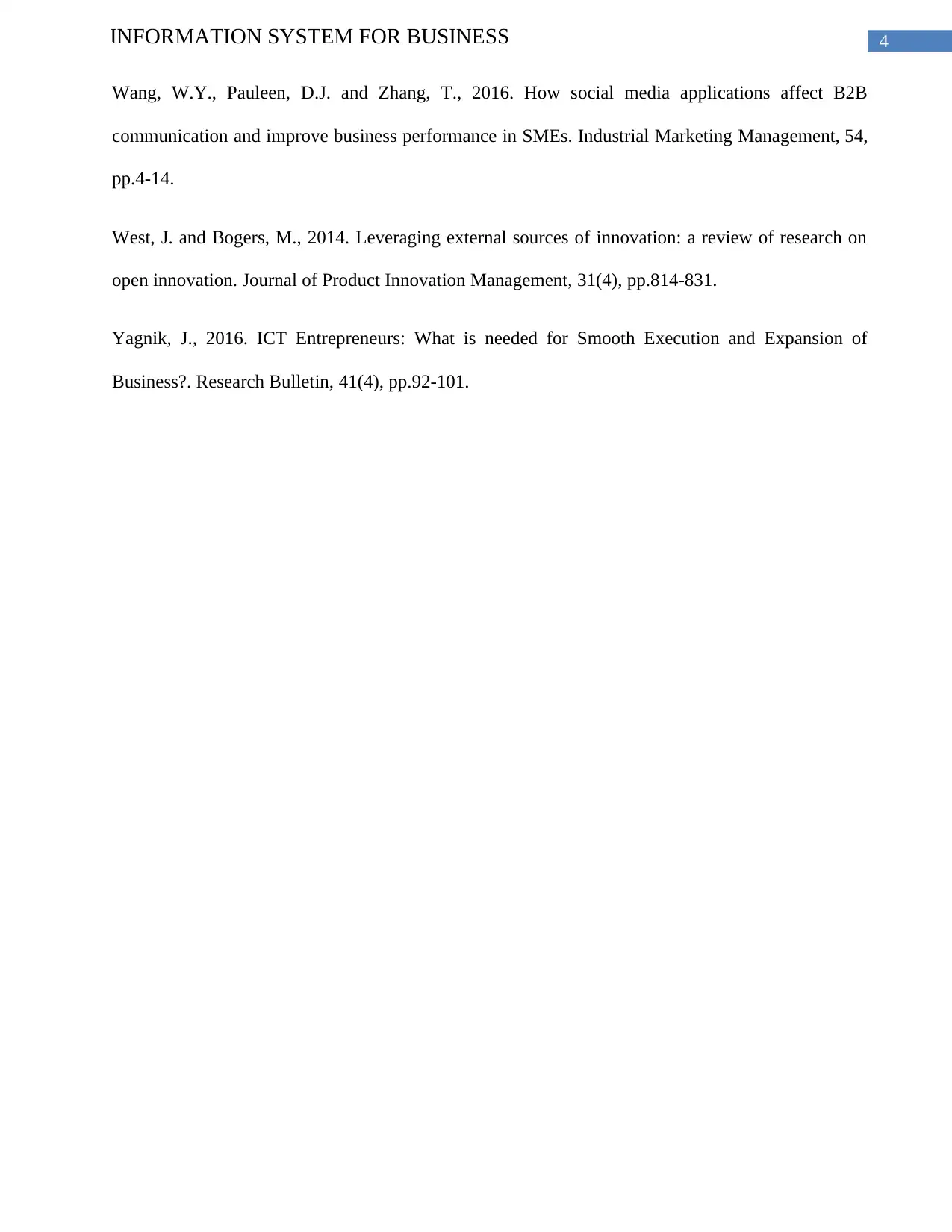
4INFORMATION SYSTEM FOR BUSINESS
Wang, W.Y., Pauleen, D.J. and Zhang, T., 2016. How social media applications affect B2B
communication and improve business performance in SMEs. Industrial Marketing Management, 54,
pp.4-14.
West, J. and Bogers, M., 2014. Leveraging external sources of innovation: a review of research on
open innovation. Journal of Product Innovation Management, 31(4), pp.814-831.
Yagnik, J., 2016. ICT Entrepreneurs: What is needed for Smooth Execution and Expansion of
Business?. Research Bulletin, 41(4), pp.92-101.
Wang, W.Y., Pauleen, D.J. and Zhang, T., 2016. How social media applications affect B2B
communication and improve business performance in SMEs. Industrial Marketing Management, 54,
pp.4-14.
West, J. and Bogers, M., 2014. Leveraging external sources of innovation: a review of research on
open innovation. Journal of Product Innovation Management, 31(4), pp.814-831.
Yagnik, J., 2016. ICT Entrepreneurs: What is needed for Smooth Execution and Expansion of
Business?. Research Bulletin, 41(4), pp.92-101.
1 out of 5
Related Documents
Your All-in-One AI-Powered Toolkit for Academic Success.
+13062052269
info@desklib.com
Available 24*7 on WhatsApp / Email
![[object Object]](/_next/static/media/star-bottom.7253800d.svg)
Unlock your academic potential
Copyright © 2020–2025 A2Z Services. All Rights Reserved. Developed and managed by ZUCOL.




